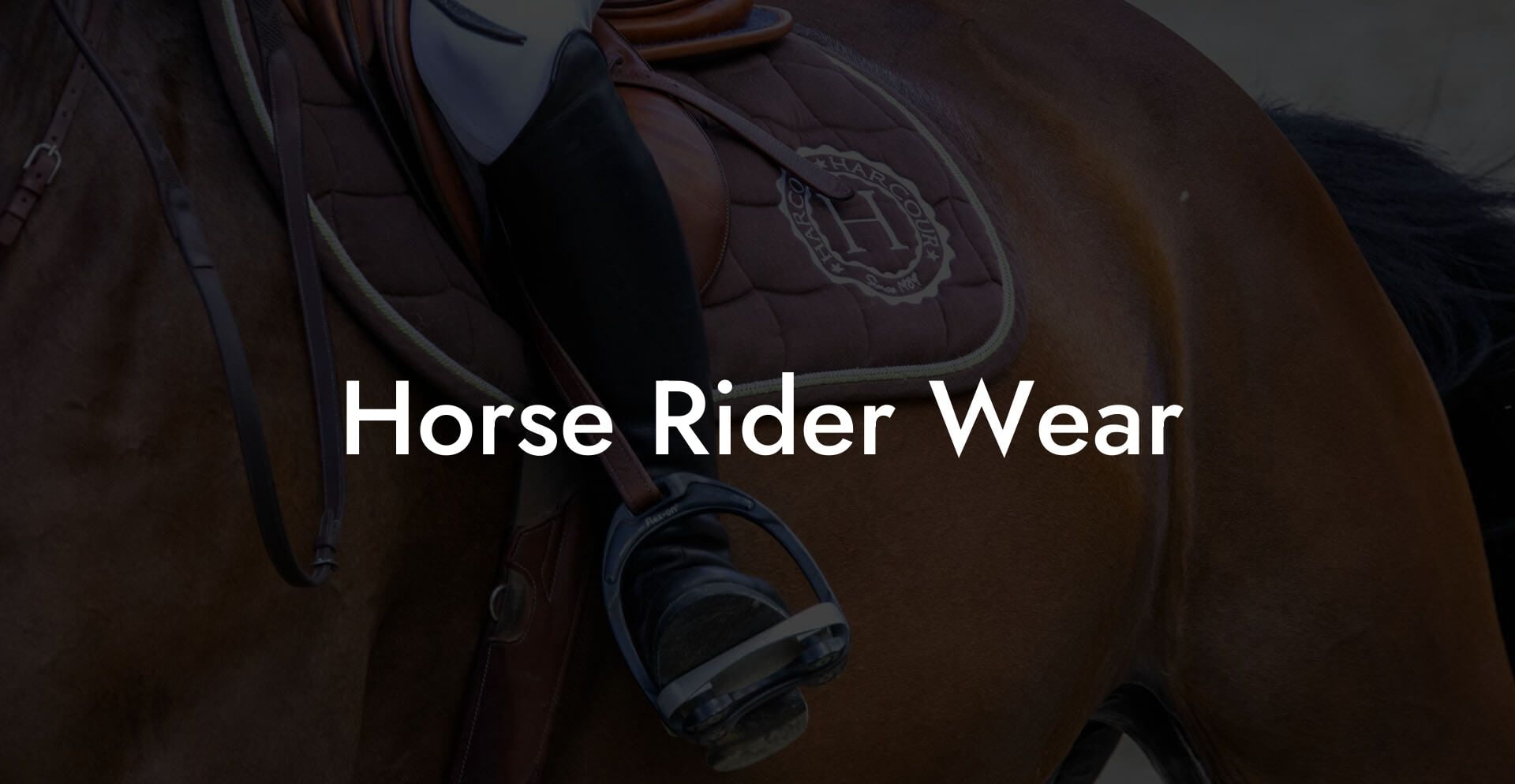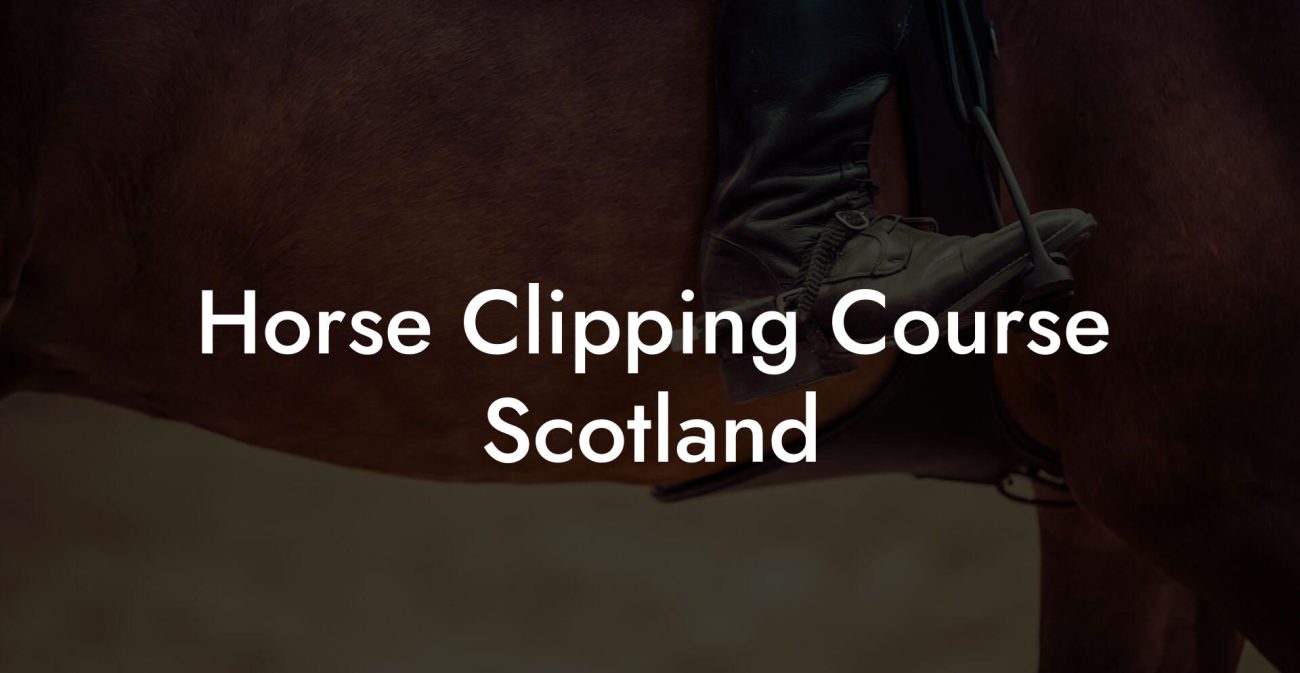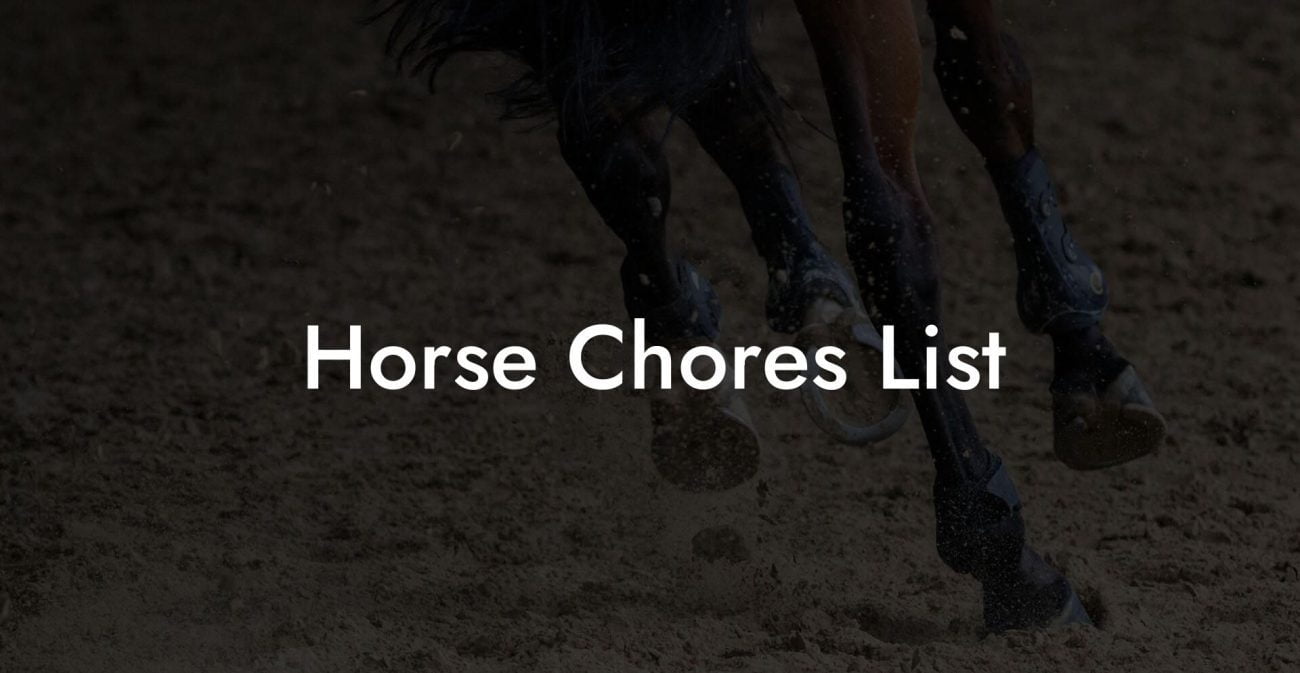Nothing beats the feeling of gearing up in slick, performance-driven horse rider wear that doesn't just make you look good but also keeps you riding like a boss. Whether you're a weekend trailblazer or a competitive equestrian, your outfit speaks volumes about your ride, your care for your horse, and your vibe. In today’s fast-paced, ever-evolving world, the fusion of style and function in equestrian apparel is more important than ever. Let’s dive headfirst into a comprehensive, no-holds-barred guide on horse rider wear that’s as much about the gear as it is about caring for your majestic steed, crafted especially for our Gen-Z and millennial riders who crave authenticity, performance, and a splash of daring flair.
Quick Links to Useful Sections
- What Exactly Is Horse Rider Wear?
- The Evolution of Equestrian Apparel: From Functional to Fabulous
- Materials and Technology: When Fabric Meets Function
- Fashion Trends in Equestrian Wear: Style on and off the Saddle
- Choosing the Right Gear: Tips and Tricks for Riders of All Levels
- Determine Your Riding Style and Needs
- Prioritize Comfort and Fit
- Invest in Quality Over Quantity
- Consider the Weather and Environment
- Stay True to Your Style
- Safety First: Essential Gear for Protecting Riders
- Caring for Your Horse: Apparel That Complements Equine Care
- Maintenance and Care: Keeping Your Horse Rider Wear in Top Shape
- Tech Meets Tradition: Smart Equestrian Wear Innovations
- Beyond the Arena: Lifestyle Benefits of Modern Horse Rider Wear
- Resources and Community Support: Your Next Steps
- FAQs on Horse Rider Wear and Equestrian Style
- Your Path Forward in the World of Equestrian Excellence
What Exactly Is Horse Rider Wear?
Horse rider wear isn’t just about donning a pair of breeches and a helmet, it’s an entire lifestyle. In modern equestrian culture, it represents a blend of technical innovation, high-performance fabrics, and cutting-edge designs that ensure safety and comfort, while still letting your personality shine. From moisture-wicking jerseys and padded jodhpurs to sturdy, stylish boots and smart helmets, the right gear can elevate your riding game and safeguard both you and your horse.
At its core, horse rider wear marries functionality with fashion. Gone are the days when riders had to compromise style for safety. Today’s equestrian apparel comes equipped with advanced materials that repel the elements, enhance movement, and guarantee that every trot, canter, or gallop is executed in comfort and confidence. This gear is a testament to innovation that meets tradition, ensuring that riders can maintain peak performance while caring for their horses like true aficionados.
The Evolution of Equestrian Apparel: From Functional to Fabulous
Step back in time, and you’ll find equestrian wear that was all about blunt utility. The early days of horseback riding were defined by heavy, restrictive clothing designed solely to offer protection during long rides. But as riding evolved from a necessity to a sport and a lifestyle, horse rider wear was revolutionized with technology and trendsetting designs.
Today, the evolution of rider wear has taken giant leaps thanks to fabric science and a dash of runway inspiration. Modern enthusiasts are spoilt for choice with innovative designs that incorporate smart textiles, think ultra-lightweight, quick-drying, and breathable materials that wick sweat away faster than you can say “giddy-up.” Contemporary rider wear doesn’t just signal athleticism and endurance; it also speaks to style, comfort, and a commitment to performance, ensuring every ride feels effortless.
In essence, the rise of modern equestrian apparel represents a paradigm shift in balancing function with flair. The evolution of horse rider wear has set a new benchmark where fashion sensibilities meet technological marvels, ensuring the modern rider has the confidence to push boundaries while maintaining animal care as a top priority.
Materials and Technology: When Fabric Meets Function
If you’re serious about your ride and your horse, you need gear that can keep up. And that’s where the magic of modern materials comes into play. Gone are the days of scratchy, bulky fabrics. Today’s equestrian wear leverages high-performance textile technology to provide unmatched comfort, durability, and flexibility.
Moisture-Wicking and Breathability: When you’re in motion, constant perspiration is inevitable. Advanced moisture-wicking fabrics pull sweat away from your skin, ensuring you remain dry no matter how intense the ride gets. Breathability is equally crucial, as it enables proper air circulation to regulate your body temperature while you bond with your horse.
Stretch and Freedom of Movement: Innovations in fabric technology mean that materials are now engineered with exceptional stretchability. This ensures that every jump, turn, or twist is unhindered by your clothing. Whether it’s a pair of flexible jodhpurs or a stretch jersey, these materials provide the freedom essential for maneuverability.
Durability and Protection: Horseback riding can be unpredictable, so your gear needs to be as tough as your riding spirit. Reinforced stitching, abrasion-resistant materials, and contemporary lacing systems ensure that your apparel isn’t just a fashion statement, but a long-lasting companion in the arena. Many modern designs incorporate light-impact protection and UV-resistant fabrics, so you’re shielded from the elements.
When high-tech fabrics meet contemporary design, the result is a gear revolution for the modern rider. It’s all about striking the right balance between cutting-edge functionality and head-turning style.
Fashion Trends in Equestrian Wear: Style on and off the Saddle
Style matters, especially when you’re out in the saddle. Today’s riders are merging the worlds of athletic wear, street style, and traditional equestrian aesthetics to create looks that are as much at home on Instagram as they are in the dressage ring. The trends this season combine edgy prints, bold accessories, and layered pieces that deliver both performance and pizzazz.
Bold Prints and Patterns: Gone are the days of plain, monotone attire. Modern rider wear often features vibrant colors, geometric patterns, or subtle animal prints that give a nod to the wild spirit of the equestrian lifestyle without compromising on class.
Sleek, Minimalist Designs: For those who prefer understated elegance, sleek designs with minimal embellishments are the way to go. These pieces focus on clean lines and functional details, making them perfect for both competitive riding events and a casual day out.
Accessory Game Strong: No outfit is complete without the right accessories. From protective yet stylish helmets to leather belts, gloves, and even smart wearable tech that monitors your performance, the accessory scene in equestrian wear is booming. These additional accents not only amp up your style quotient but also pack serious functionality.
Mixing Functionality with Urban Chic: What’s catching on with the younger crowd is the unexpected fusion of urban streetwear with traditional equestrian elements. Think bomber jackets paired with riding boots or distressed denim with equestrian-inspired details, a trend that truly redefines the look of modern horsemanship.
These trends illustrate that horse rider wear isn’t just about the gear, it’s about self-expression and showcasing a lifestyle that’s both active and artistically inspired.
Choosing the Right Gear: Tips and Tricks for Riders of All Levels
Selecting the perfect equestrian apparel can feel like choosing the right dance partner, it’s all about fit, feel, and flair. Whether you’re a newbie or a seasoned pro, the following tips can help you navigate the bustling world of horse rider wear:
Determine Your Riding Style and Needs
Ask yourself: What’s my riding genre? Are you chasing the thrill of competitive events or just out for a leisurely ride? Your riding style dictates whether you need robust, padded gear for jumping events or flexible, comfortable apparel for trail riding.
Prioritize Comfort and Fit
Your comfort should be your top priority. Gear that fits perfectly not only enhances performance but also prevents chafing and discomfort during long hours on horseback. Look for adjustable waistband breeches, ergonomically designed helmets, and boots that offer both support and flexibility. Many brands today offer sizing options that consider distinct body shapes, ensuring a snug fit without sacrificing mobility.
Invest in Quality Over Quantity
It can be tempting to stock up on the latest trends, but investing in durable, high-quality pieces will pay off in the long run. Superior fabrics and construction mean your gear will withstand the rigors of daily riding and occasional mishaps. Remember, a well-made pair of riding boots or a reliable helmet is an investment in your safety and performance.
Consider the Weather and Environment
Riding conditions can vary widely; from blazing summer days to chilly winter mornings. Seek out gear designed specifically for different climates, think insulated jackets for cold weather rides and lightweight, UV-protected jerseys for sunny days. Layering is key, so opt for pieces that work well together to maintain comfort no matter what.
Stay True to Your Style
Last but by no means least, choose gear that resonates with your personal style. When you feel good about what you wear, it boosts your confidence and complements your connection with your horse. Whether it’s an avant-garde pattern or a timeless classic, let your outfit be a reflection of your personality and passion for riding.
By combining these practical tips with an understanding of your riding needs, you can build a wardrobe that not only protects you in the arena but also expresses your individuality both on- and off-the-horse.
Safety First: Essential Gear for Protecting Riders
Safety should always be the cornerstone of any riding experience. While fashionable gear is fun, nothing beats the peace of mind that comes with knowing you’re protected. Today’s safety gear in horse rider wear is engineered to meet strict standards without sacrificing style.
Helmets: Your first line of defense, a well-fitting helmet is a non-negotiable. Modern helmets provide impact-resistant protection along with vents and moisture-wicking linings, keeping you cool and comfortable even during high-energy rides.
Riding Boots: A pair of sturdy riding boots not only offer protection but also enhance your control and balance. Look for boots with reinforced soles, secure fastenings, and weather-resistant materials that ensure durability.
Protective Vests and Body Protectors: For high-performance riders, especially those participating in jumps and fast-paced events, vests and body protectors provide that extra layer of security. These pieces are designed to absorb impact forces and reduce the risk of injury.
Gloves and Arm Guards: Gloves offer a better grip and reduce friction, while arm guards protect you during falls or sudden movements. These accessories, often overlooked, are important components that complete your equestrian safety attire.
In today’s market, you can find safety gear that looks as good as it performs, melding advanced engineering with a sleek design. Riding smart means being stylish while never compromising on protection.
Caring for Your Horse: Apparel That Complements Equine Care
Horse rider wear isn’t just about you, it’s about the incredible bond you share with your horse. The right gear can actually enhance your ability to care for your equine partner, keeping you agile and responsive during every grooming session, trail ride, and competitive event.
Mobility and Accessibility: When you’re comfortable and unrestricted in your riding apparel, you can focus on tasks like brushing, saddling, and connecting with your horse. Many modern designs include smart pockets and adjustable fits, allowing you to easily store essentials such as grooming tools, cell phones, or even treats for your horse.
Temperature Regulation: Just as horses need to stay cool or warm depending on the season, so do you. Equestrian wear crafted from moisture-wicking and insulating fabrics ensures that you’re comfortable in all seasons. This attention to detail means that you can focus on the wellbeing of your horse without worrying about your own comfort.
Durability for Rough Rides: Horses are powerful and unpredictable. Whether you’re embarking on a cross-country trail or navigating a busy arena, rider wear with reinforced stitching and abrasion-resistant elements guarantees that you’re prepared for any adventure, enabling you to care for your horse even under challenging conditions.
Ultimately, the synergy between effective rider wear and attentive horse care ensures that both you and your equine companion receive the best of both worlds, style, performance, and a shared passion for riding.
Maintenance and Care: Keeping Your Horse Rider Wear in Top Shape
Investing in high-quality equestrian apparel means you need to know how to care for it properly. Regular maintenance not only helps in preserving the integrity of your gear but also ensures it continues to perform well, ride after ride.
Washing and Drying: Always check the care labels on your wearable pieces. Most modern fabrics are machine washable on a gentle cycle, though hand-washing might be recommended for delicate materials. Air-drying is usually best to maintain fabric integrity and prevent shrinkage.
Storage Tips: Keep your gear in a cool, dry place away from direct sunlight and moisture. For items like helmets and boots, proper storage in a designated locker or bag can prevent deformation and extend their life.
Repair and Maintenance: Don’t let minor issues escalate, patch up small tears or replace worn-out fasteners as soon as possible. Some brands even offer repair services, so you can get your favorite pair of breeches or jacket back in prime condition without having to start from scratch.
Regular Inspections: Give your gear periodic inspections before each ride. Check for loose stitching, damaged zippers, or worn-out padding. A proactive approach to maintenance can prevent gear failure during crucial riding moments.
With these tips, your rider wear remains as dependable as the day you first hit the arena. After all, quality gear deserves quality care, ensuring that every ride is both safe and stylish.
Tech Meets Tradition: Smart Equestrian Wear Innovations
In the age of smart tech, even horse rider wear is getting a futuristic upgrade. Imagine gear that not only adapts to your body but also keeps track of your performance, heart rate, and even the environmental conditions during your ride.
Wearable Tech: From smart helmets with built-in communication systems to fitness trackers integrated into your riding jacket, technology is revolutionizing how riders interact with their gear. These tools provide real-time insights into your performance, enhancing your training and ensuring that you make data-driven improvements.
Embedded Sensors and Mobile Apps: Some brands have developed portable sensors that can be attached to your gear. These sensors connect to mobile apps, tracking vital statistics such as temperature, humidity, and even the vibrations and impacts during riding. This data not only helps in fine-tuning your technique but also adds a layer of safety by detecting any unusual riding patterns.
Customizable Fit and Design: Technology now allows for customizable apparel adjustments. With the integration of smart fabrics, some rider wear can adapt its fit in real time, ensuring optimal support and comfort throughout the ride. This fusion of high-tech sensors and traditional craftsmanship marks a new era in equestrian wear that is as innovative as it is stylish.
These innovations are pushing the boundaries of what rider wear can do, merging high technology with centuries of equestrian tradition to create gear that not only protects but also informs and inspires.
Beyond the Arena: Lifestyle Benefits of Modern Horse Rider Wear
The benefits of cutting-edge equestrian apparel extend well beyond the confines of the arena. For the modern rider, this gear seamlessly transitions into everyday life, influencing everything from casual outings to social media feeds. Here’s how modern horse rider wear elevates your lifestyle:
Versatility and Comfort: High-quality gear is designed to be versatile. Many pieces can take you from riding lessons to brunch with friends, maintaining their form and functionality without sacrificing style.
Boosting Confidence: There’s a psychological edge to wearing well-designed, performance-oriented apparel. When you know your gear is both stylish and dependable, it enhances your overall confidence, on the saddle and off.
Social Media and Community: In the age of Instagram and TikTok, your outfit is your brand. Modern equestrian wear comes in designs that pop on camera, making you the envy of riders worldwide. Flaunt your style, share your adventures, and connect with a community of fellow horse lovers who appreciate quality and innovation.
Eco-Friendly and Sustainable Options: With growing awareness about sustainability, many equestrian brands are embracing eco-friendly practices. From recycled fabrics to ethical production standards, the new wave of horse rider wear shows that caring for your horse and the planet can go hand in hand.
The lifestyle benefits of modern rider wear further highlight its role as more than just equipment, they’re an integral part of living your equestrian passion with pride and panache.
Resources and Community Support: Your Next Steps
Ready to upgrade your wardrobe, dial in your gear maintenance, and truly elevate your riding experience? Dive into a world of resources and community support that caters to both your style and your practical needs. Whether you're a newbie looking to learn the ropes or a seasoned competitor, there’s a community of fellow riders, trainers, and gear enthusiasts waiting to share insights, tips, and the latest trends.
Online Forums and Social Media Groups: Platforms like Instagram, TikTok, and specialized equestrian forums are buzzing with discussions on the latest in horse rider wear. Follow your favorite brands and influencers to get real-time updates on trends, tech innovations, and exclusive offers.
Equestrian Blogs and Podcasts: Stay informed with content from industry experts who break down gear trends, share success stories, and offer advice on everything from gear care to practical riding tips. These platforms are goldmines for learning the nuances of modern equestrian apparel.
Local Riding Clubs and Workshops: Nothing beats hands-on experience. Many local riding clubs host events and workshops dedicated to gear demonstration, safety drills, and maintenance techniques. Connecting with fellow equestrians can enrich your understanding and keep your passion for riding ignited.
Retail and Brand Collaborations: Keep an eye out for collaborations between popular equestrian brands and influencers. These partnerships often bring limited-edition collections that merge cutting-edge technology with trendsetting design, ensuring you always have the best in horse rider wear.
Embrace these resources to stay updated, learn continuously, and grow as both a rider and a member of an ever-supportive equestrian community. Your next steps are just a click, or ride, away.
FAQs on Horse Rider Wear and Equestrian Style
Got questions? We’ve got answers. Here’s a roundup of some of the most commonly asked queries about horse rider wear, gear maintenance, and the latest trends in equestrian apparel.
1. What is horse rider wear?
Horse rider wear refers to equestrian apparel and gear designed specifically for riding. It combines technical functionality with stylish designs to ensure safety, comfort, and performance for both competitive and casual riders.
2. Why is moisture-wicking technology important in rider wear?
Moisture-wicking fabrics pull sweat away from your skin, keeping you dry and comfortable during rides. This technology is vital for regulating body temperature and ensuring optimal performance.
3. How do I choose the right fit for my riding breeches and boots?
Comfort and mobility are key. Look for adjustable features and reliable sizing charts provided by the brand. It's also a good idea to try on different styles to see which fit best supports your riding style.
4. Are there sustainable options in modern equestrian apparel?
Yes, many equestrian brands now offer eco-friendly gear made from recycled materials and using sustainable production processes. This allows riders to enjoy high-quality gear while contributing to environmental conservation.
5. What safety features should I look for in horse rider wear?
Key safety features include impact-resistant helmets, reinforced riding boots, and protective vests. Additionally, look for gear that is designed with ergonomic padding and secure closures to ensure maximum safety during rides.
6. Can smart technology really improve my riding experience?
Absolutely. Innovations like wearable sensors and connected gear can provide real-time feedback on performance, help monitor vital stats, and even adjust the fit of your apparel, all contributing to a smarter, safer riding experience.
7. How should I maintain and clean my equestrian gear?
Always follow the manufacturer’s care instructions. Most modern gear is designed for easy machine or hand washing on a gentle cycle. Air-dry your apparel to maintain its longevity and performance.
8. Where can I find the latest trends in horse rider wear?
Keep up with leading equestrian brands on social media, read equestrian blogs, and join riding communities online. Local events and trade shows are also great places to discover new styles and technological innovations.
Your Path Forward in the World of Equestrian Excellence
Embracing the realm of horse rider wear is more than just updating your wardrobe; it’s about stepping into a lifestyle where passion meets performance. The dynamic fusion of technology, style, and tradition now offers every rider the opportunity to feel empowered, protected, and undeniably cool. With innovations driving the gear market and a vibrant community of fellow equestrians, your journey into modern equestrian gear is just beginning.
Whether you’re refining your riding technique, gearing up for a competitive event, or simply enjoying a laid-back trail ride, the right apparel can transform your experience. Let your outfit be a reflection of your unique personality and your deep bond with your horse. With high-performance fabrics, smart design, and a commitment to both safety and style, your rider wear keeps you at the forefront of equestrian trends.
There’s never been a better time to upgrade your look and invest in pieces that are as innovative as they are timeless. Embrace the blend of modern tech and classic equestrian charm, and watch as your riding adventures become not just safer and more comfortable, but also an iconic expression of who you are.
The arena is calling, gear up, ride with passion, and redefine what it means to connect with both your sport and your horse. Your journey to equestrian excellence is in your hands. Step forward, be bold, and let every ride be a story worth telling.













